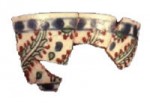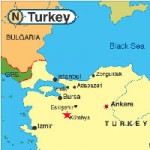Turkish Delights at a Dutchman’s Site
In the 16th through 18th centuries, Kutahya was the center of ceramic production in Turkey. Kutahya was the successor to Iznik, the more modern name for Nicaea. Iznik is located between Kutahya and Istanbul and served as the principal production site for highly decorated Turkish ceramics in the preceding centuries. Both Iznik and Kutahya were well known for their decorative tiles in addition to their ceramic vessels. These brightly decorated ceramics using a range of rich colors were shipped throughout the Islamic world and imported into Europe from this specialized ceramic center.
Our specimens have this polychrome decoration in blue, green, red, and black outlining on a white ground. The glaze is based on alkaline compounds. The blue is from cobalt while the green is from copper, and the black most likely came from manganese. The red comes from very special iron-rich clay called Armenian bole which was supposed to have medical as well as artistic applications. While never exploited as a pottery decoration, Father Andrew White in his Relation of Maryland mentions among the mineral riches of the new colony “a red soile like Bolearmonicke.” Armenian bole is still available and is used by artists in preparing surfacesfor gilding.
This type of ceramic has only been found on four other archaeological sites in North America. Two of these are located in Williamsburg, Virginia, while the other two are in Nova Scotia, Canada. The Williamsburg examples come from Raleigh Tavern and Weatherburn’s Tavern while the Canadian examples are from Fortress Louisburg and Canso on Cape Breton. The Nova Scotia and Williamsburg examples clearly date to the 18th century while our example may date to either the late 17th or early 18th century.
On the last day of August, I (ed. note: Laboratory Director Silas Hurry) had the opportunity to visit Winterthur Museum in Delaware which owns a complete cup and saucer of this material. I was able to measure it and compare it to our specimens. Their example is much more like the specimen recovered from Fortress Louisburg, using a palette that includes yellow along with blue, red, black, and white of our specimens. The colors on our examples seem somewhat richer while the Winterthur and Louisburg examples are paler and in some areas rather “watery” in appearance.Research continues into the significance and distribution of this unusual pottery.

Ceramic found on the site of Van Sweringen’s inn.

Kutahya was the center of ceramic production in Turkey between the 16th and 18th centuries.

Specimen recovered from Fortress Louisburg




